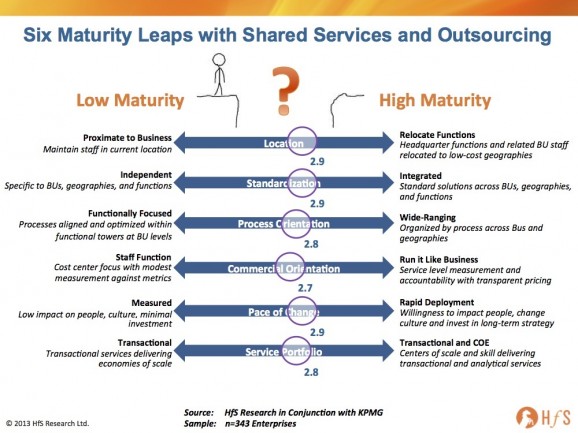
Are you feeling relephant?
One of the great discussion topics coming out of the recent Blueprint 3.0 sessions in New York was centered on how enterprise operations can progress beyond the “ordinary” and avoid fading into the netherworld of corporate insignificance. Or, as one member profoundly stated, “We really need to stop being really good at irrelevant stuff”. So let’s take a look at how they can start to do just that…
It’s all about shifting the whole foci of operations from yesterday’s fragmented immaturity to tomorrow’s mature model
Let’s examine the six maturity leaps we identified during our recent GBS study of major enterprises with KPMG:
- Location leap: from high-cost to low-cost locales; Do we really need to process those insurance claims in New Jersey?
- Standardization leap: from independent standards tied to BUs and geos to enterprise-wide standard solutions; Why do we have 14 instances of ERP, when we can rollout multi-tenant cloud solutions and kill the dysfunction and poor data integration?
- Process Orientation leap: from siloed processes within BUs to business-wide process alignment across geographies and broad functions; Why do we need 153 different ways to pay suppliers and process invoices?
- Commercial Orientation leap: from operating like a cost center to being measured as a business service center; Why wouldn’t we want to have centralized operations servicing our enterprise with the skill, scale and efficiency of a professional services firm, than some back office cube-farm which constantly gets beaten up for cost and quality, which the BUs barely use in any case?
- Pace of Change leap: from low-impact change to a genuine willingness to impact people and invest in long-term strategies; Rolling out a “Big Data” roadmap takes enterprises 5-10 years – how can you be serious about a strategic roadmap when every action is reactive and short-term in nature?
- Service Portfolio leap: from being merely transactional to delivering both transactional skills and analytical services at scale. Transactional process are ultimately automated, or outsourced (or both) – especially if these are delivered inefficiently, which means operations teams need to deliver business value and analysis if they want to thrive in today’s business environment.
The Bottom-line: In 2014, ambitious operations leaders must begin achieve a certain degree of maturity across their operations before they can really address achieving their desired outcomes
Our research has clearly shown that enterprises can’t achieve anything near their desired levels of cost-reduction, analytics quality or innovation, if their operations and processes are fragmented and poorly aligned with the corporate goals of the business. Outsourcing and shared services can provide levers to access expertise (often at lower cost) and standard ways of managing process flows. However, it is the job of the governance organization to take oversight control of end-to-end processes and work with their BU leaders to map out a long-term roadmap to get better access to data and achieve consistent, ongoing cost efficiencies.
Global Business Services isn’t just about managing a few provider contracts and beating up on poorly performing shared service centers – it’s about re-aligning the enter operations function (the old “COO’s office”) to support the business with a commercial orientation. A GBS operation needs to operate like a consultative service provider that can deliver ongoing expertise, processing capability and analytical services in a scalable fashion. GBS executives needs to pull together both the internal and external resources to make this happen. Smart service providers will (and some already are) positioning themselves as partners to support their clients’ GBS strategies, while smart sourcing advisors know they need to address the broader GBS transformation needs of their clients, or face being relegated to supporting contract procurement.
Stay tuned for Part II of our 2014 outlook, we will analyze the performance of enterprises against their desired business outcomes, based on their maturity levels.
Readers can also access our complimentary new report, “The Global Business Services Industry Study“, produced in conjunction with KPMG LLP, where we interviewed 416 enterprises across a cross section of regions and industries about their GBS activities, priorities, drivers, constraints, and plans.
Posted in : Business Process Outsourcing (BPO), Captives and Shared Services Strategies, Cloud Computing, GBS 2013 Study, Global Business Services, IT Outsourcing / IT Services, kpo-analytics, Outsourcing Advisors, Procurement and Supply Chain, SaaS, PaaS, IaaS and BPaaS, smac-and-big-data, Sourcing Best Practises, Sourcing Locations, sourcing-change, Talent in Sourcing, the-industry-speaks







A mature business can sell to its customers from the most out of the way places. I work in returns, and I receive many customer calls, asking questions about our product offerings. I listen empathetically, ask some open ended questions to gain a better understanding of what the customer needs, and then I close with a helpful suggestion. I have made direct and indirect sales with this approach, even though on paper, I am just a Warehouse Associate-Returns specialist.
[…] 2014 shared services and outsourcing outlook Part I […]
[…] my view, GBS is only BS if you can’t make the Six Maturity Leaps we discussed during Part I, where ambitious enterprises must lay the groundwork to shift from siloed, immature shared services […]
[…] These include (as detailed in this HFS post) […]
[…] The implications of evolving to a GBS model are significant for all affected enterprises, but possibly none more so than those responsible for service delivery governance, as described in our Six Maturity Leaps. […]
[…] The implications of evolving to a GBS model are significant for all affected enterprises, but possibly none more so than those responsible for service delivery governance, as described in our Six Maturity Leaps. […]
[…] These include (as detailed in this HFS post) […]
Hi Cyrus,We can use the following steps to inmmelept ITIL in any industry:a) Assess the business processes that can benefit from inmmelepting ITIL. Experts point out a range of different business processes to which business owners or leaders can apply ITIL. These include problem management or change management as well as incident handling and some other types of business issues like capacity, financial accounting and supply chains.b) Use benchmarks to evaluate existing processes. Often, it’s important to start at the beginning and document how existing processes work in order to build an environment for inmmelepting ITIL and improving certain aspects of the business.c) Make goals. In order to inmmelept ITIL effectively, you’ll want to have goals and objectives on hand in order to craft strategies that will work.Use people-centered tactics to assess business processes, set goals and achieve them by inmmelepting ITIL. Those who are experienced in business communications know that it’s important to reach out to individuals to get them engaged and active in promoting this sort of business strategy. This may require some creativity from a management perspective, but according to many of those who have used ideas like ITIL to streamline business operations, getting more hands on deck is critical.d) Narrow down the options for improving processes. Some businesses may need to cull their original list and further identify viable improvements as needed.e) Identify gaps between your goals and your existing processes. Defining the problem or the gap helps business leadership to craft the right kinds of responses and strategies.f) Get access to a project management methodology. Some business consultants recommend specific methods for inmmelepting ITIL. In other situations, it might be as simple as creating relevant PowerPoint applications with conventional project management charts, including timelines and other resources as necessary.g) Measure improvements. When ITIL has been inmmelepted, it’s a good idea to keep looking at current operations to observe whether or not these strategies are paying off as they should.Hope this helps.Regards,James